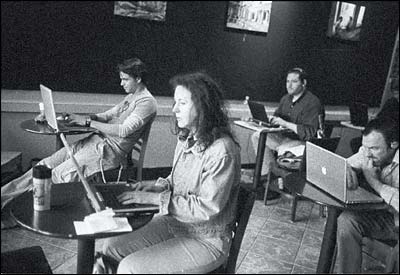
Everyone agrees: The Internet has finally come of age. Dot-coms are profitable and thriving, serious real-world companies are doing business online, entrepreneurs and executives are lauded as visionaries, Internet analysts are ubiquitous and admired, and the financial pages are dominated by high-priced stocks with wacky names. It’s a lot like the late nineties, but this time measured by cash flow rather than eyeballs.
What is grating about much of the coming-of-age commentary, however, is its patronizing tone. It’s as if the late nineties were a mistake, a botched job to be discarded and never thought of again. But in fact, prior Internet efforts were anything but a waste of time. On the contrary, they were the only way to get from there to here.
Industries usually progress through four eras—boom, bust, growth, and decay—and the Internet is now in the early years of the third. The good news is that this phase is usually the longest and most profitable of the four. The PC industry boomed and busted in the early eighties; Dell, Microsoft, and other postdiluvian survivors have made a killing since.
Amid the pain and embarrassment of failure, it is easy to forget that industries cannot develop without it. In the Internet’s ten-year commercial history, thousands of companies have experimented with hundreds of thousands of ideas. Some of the Internet experiments have worked; most haven’t. Investors have alternately gone hog wild and stone cold. In 2000, the mother of all busts wiped out a generation of misfits and cleared the decks for today’s survivors.
Nowadays, nearly a billion people jack into a medium that, a decade ago, few had heard of. Hundreds of millions use e-mail and instant messaging, bid at eBay, search at Google, or shop at Amazon. Given the rate of innovation, the Internet’s impact might be greater over the next decade. And by then, the medium will be as mature as television in 1946.
But acknowledging the pedigree of the current prosperity would spoil the critics’ fun. With everything obvious in hindsight, the nineties frenzy of experimentation is viewed as a kindergarten recess run amok (which, admittedly, is what it often felt like). Armchair quarterbacks skewer everyone and everything that didn’t survive the bust: dot-com communities, pet stores, furniture stores, B2B market-makers, “push.” Cackles about the idiocy of Webvan’s home-grocery-delivery concept are almost as loud as the rumble of FreshDirect trucks. And when Edison was working on the lightbulb, he wasted gobs of time and money trying some 6,000 filament materials before using—duh—carbonized thread. What an idiot.
(Okay, fine, some ideas were ridiculous. As a Merrill-Lynch analyst, I thought that the AOL–Time Warner merger would work. The second-dumbest idea I ever heard was for a company that synchronized television, print, and computer ads with a patented musical technology and a personal bar-code scanner shaped like a cat. “Cat-scan”—get it? Even I hated that one.) Those who regard failure as an embarrassment instead of a process can take solace in the fact that even market busts are productive. The Great Crash of 1929 led to the creation of the SEC and most of our securities laws. Similarly, the bear market of 2000 and 2001 created the atmosphere of anger and resentment necessary for those laws to be overhauled.
One of the overused mantras of the nineties was “creative destruction.” Bull markets highlight the creative half of the process; bear markets, the destruction. One lesson of the Internet’s first decade is that we can’t have one without the other.